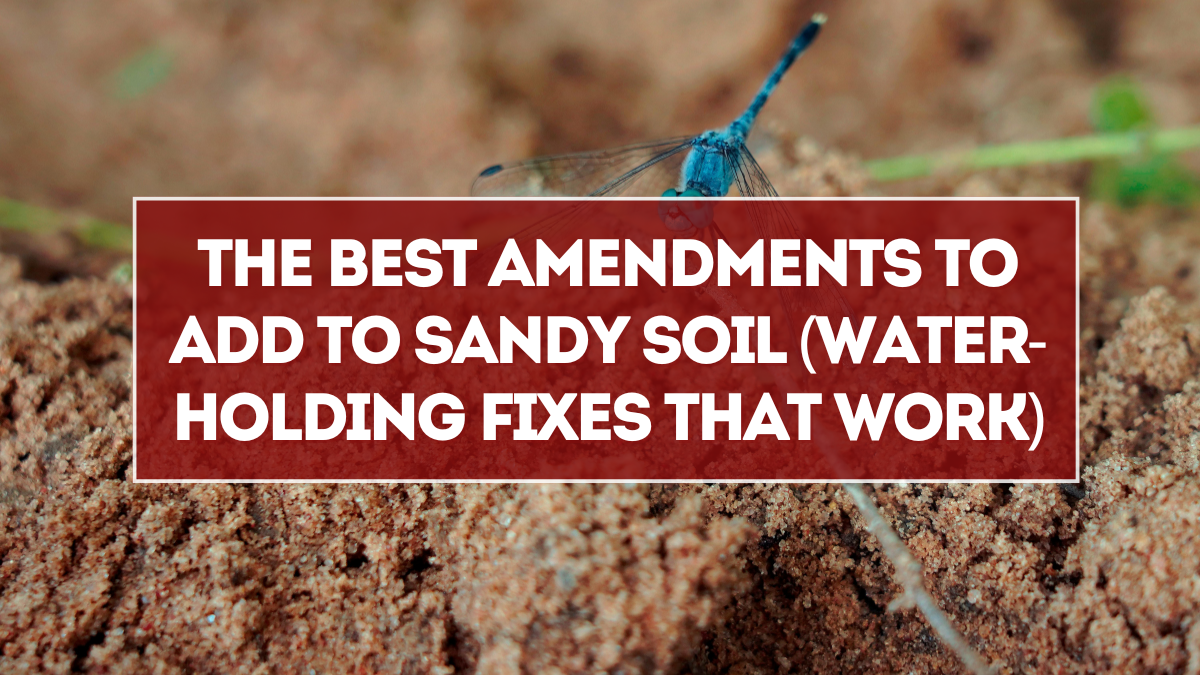If you’ve ever tried gardening in sandy soil, you know the struggle. Water drains away almost immediately, nutrients leach out quickly, and plants are left thirsty and underfed. While sandy soil has advantages like good aeration and easy tilling, it often lacks the ability to retain moisture and fertility. The solution lies in choosing the best amendments for sandy soil—materials that improve structure, hold water, and boost nutrient availability.
By adding the right combination of organic and mineral amendments, you can transform light, beachy soil into a productive growing medium that supports vegetables, flowers, and lawns. This article explains the top soil amendments that actually work, how they function, and how to apply them effectively.

Why Sandy Soil Needs Amendments
Sandy soil particles are large, which leaves big gaps between them. These gaps allow water to drain rapidly, but they also make it difficult for soil to hold nutrients. Without amendments, plants grown in sandy soil often show:
-
Wilting shortly after watering
-
Poor nutrient uptake despite fertilization
-
Shallow root systems
-
Uneven growth or yellowing leaves
Adding the right amendments changes the soil structure by filling gaps, increasing moisture retention, and improving microbial activity.
Compost: The Ultimate Amendment
If you only add one amendment to sandy soil, make it compost. Compost improves soil in multiple ways:
-
Increases water-holding capacity by binding particles together.
-
Provides a slow release of nutrients that sandy soils typically lack.
-
Boosts beneficial microbes that improve soil health.
How to use it: Spread 2–3 inches of compost over garden beds and mix it into the top 6–8 inches of soil. Repeat annually for lasting results.
Biochar: Long-Term Water and Nutrient Retention
Biochar is a carbon-rich material created by burning organic matter in low oxygen. It acts like a sponge in sandy soils, holding both moisture and nutrients. Unlike compost, which breaks down over time, biochar lasts for decades.
Benefits:
-
Increases soil’s ability to hold water.
-
Reduces nutrient leaching.
-
Supports beneficial microorganisms.
How to use it: Mix biochar into the topsoil at a ratio of about 5–10% by volume. Pre-charge it with compost or organic fertilizer before use to avoid temporary nutrient tie-up.
Clay Fines: Improving Soil Structure
Adding clay fines to sandy soil balances texture. Because clay particles are tiny, they fill the gaps between sand particles and slow drainage.
Benefits:
-
Improves structure and reduces quick drying.
-
Enhances nutrient retention through cation exchange.
How to use it: Incorporate clay fines in small amounts to avoid creating overly heavy soil. Mixing clay with compost helps blend the textures effectively.
Coco Coir: A Sustainable Water Holder
Coco coir, made from coconut husks, has become a popular soil amendment thanks to its sustainability and excellent water-holding properties.
Benefits:
-
Retains water while still providing good aeration.
-
Breaks down slowly, offering long-term improvement.
-
Neutral pH, making it versatile for most plants.
How to use it: Mix coco coir into sandy soil at a 1:3 ratio with compost or garden soil for best results. It’s especially effective in raised beds and containers.
Wetting Agents: Fixing Water Repellency
One challenge of sandy soil is that it can become hydrophobic, meaning water beads on the surface instead of soaking in. Wetting agents—either natural like yucca extract or synthetic—help water penetrate evenly.
Benefits:
-
Prevents water runoff.
-
Ensures moisture spreads throughout the root zone.
How to use it: Apply according to instructions, usually diluted in water and sprayed onto soil. Use sparingly, as overuse may harm soil biology.
Mulch: Surface Protection
Adding organic mulch on top of sandy soil reduces evaporation and keeps the soil cooler. Over time, mulch breaks down and further enriches the soil.
Best mulches for sandy soil include:
-
Straw or hay
-
Shredded leaves
-
Wood chips
-
Pine needles
How to use it: Apply a 2–4 inch layer around plants, keeping mulch slightly away from stems to prevent rot.
Step-by-Step Sandy Soil Improvement Plan
-
Spread 2–3 inches of compost and work it into the top 6–8 inches.
-
Add biochar at 5–10% volume, pre-charged with compost or fertilizer.
-
Mix in small amounts of clay fines to improve texture.
-
Blend coco coir for long-lasting water retention.
-
Apply a natural wetting agent if water is not soaking evenly.
-
Top with mulch to lock in moisture and protect soil.
By repeating this process yearly, sandy soil gradually becomes loamy, fertile, and capable of supporting strong plant growth.
Crops That Benefit Most
Plants that thrive after amending sandy soil include:
-
Vegetables like tomatoes, cucumbers, carrots, and beans.
-
Fruit trees such as citrus and apples.
-
Herbs including basil, parsley, and oregano.
-
Turfgrass that needs consistent moisture during summer.
Mistakes to Avoid
-
Adding too much clay at once, which can turn sandy soil into hard, compacted soil.
-
Using only chemical fertilizers without organic amendments—nutrients will still leach quickly.
-
Skipping mulch, which leaves sandy soil exposed to fast drying.
-
Expecting overnight results—soil improvement is gradual and cumulative.
Why Long-Term Soil Health Matters
Improving sandy soil isn’t just about better harvests; it’s about sustainability. Each amendment plays a role in making soil more resilient to drought, reducing reliance on synthetic fertilizers, and supporting biodiversity underground. Over time, your garden becomes more self-sustaining, requiring less effort while producing healthier plants.
FAQs
How often should I add compost to sandy soil?
At least once a year, ideally in spring or fall, to continuously build organic matter.
Can sandy soil be turned into loam?
Yes, with consistent additions of compost, biochar, and clay fines, sandy soil can develop loamy characteristics over several seasons.
Is coco coir better than peat moss for sandy soil?
Yes. Coco coir is more sustainable, holds water well, and lasts longer without breaking down quickly.
Do wetting agents harm soil microbes?
Natural wetting agents like yucca extract are safe, while synthetic ones should be used sparingly to avoid disruption.
What’s the quickest fix for sandy soil?
Adding compost and applying mulch provide the fastest short-term results, while biochar and clay fines build long-term improvement.
Click here to know more.
